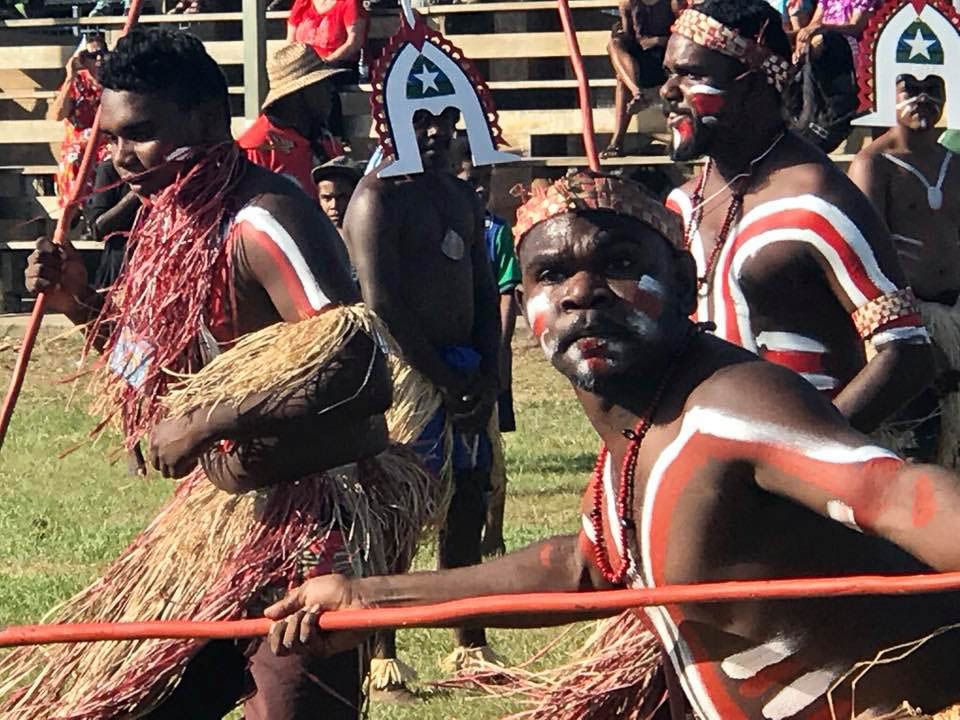The Zapotec concept of guendalisaà often involves the contributions members of a community make to festival events, such as processions. This entails beautifully made costumes, masks, floats and decorations. This dimension of creative life is often overlooked because it is not permanent and is found outside the gallery where art is conventionally identified. In this online exhibition, we gather from the Garland community glimpses of the kind of objects made for parade across our wider world.
Leitha Assan
The 2018 Winds of Zenadth Kes Festival is a showcase of the rich and unique Torres Strait culture that is celebrated over a period of 3 days. Celebrating this year’s theme of Muruyguw Kupay Ngalpun Gataboeradhar (Stand Strong: Culture is our Foundation) the region’s diversity can be experienced through spectacular traditional dance performances, cultural demonstrations, model boat races and traditional and contemporary art and crafts. The infusion of multiculturalism is also very obvious in the beautiful aroma and taste of ailan kai kai (Island food) that are sold from the various food stalls.
19 communities from the Torres Strait and Northern Peninsula Area gathered to revitalise, preserve and practice our language, art, culture and ceremonies. A special time and place for our families and friends some of whom have travelled from across Australia or the world to gather and reconnect with their kin and grassroots culture.
Young men from the Purple Spider dance team from Erub and Ugar Islands performing the Kab Kar.
- Purple Spider Dance Team – Erub Island, photo: Alima Ahwang Smit
- Purple Spider Dance Team – Erub Island, photo: Alima Ahwang Smit
- Purple Spider Dance Team – Erub Island, photo: Alima Ahwang Smit
Thaiwa men’s dance team from Iama Island performing a dinghy dance.
- Iama Island Dancers, photo courtesy of Leitha Assan
- Iama Island Dancer, photo courtesy of Leitha Assan
Sereb Sereb Narr or Thugul Makar Sagul is a traditional model canoe race.
Lockhart dancers from the Aboriginal community of Lockhart on Cape York Peninsula.
Women from Masig Island performing a bow and arrow dance.
Young men and women from Wugalgau Kaiin Thithu dance team from St Pauls community on Mua Island performing zamiyakal (dance objects) dances.
- Mua Island Dancers – St Pauls Community – Women, photo courtesy of Leitha Assan
- Mua Island Dancers – Men, photo courtesy of Leitha Assan
Saibai Island dancers from Muyngu Koekoper dance team.
- Saibai Island Dancers – Men, photo courtesy of Leitha Assan
- Saibai Island Dancers – Women, photo courtesy of Leitha Assan
Festival float day where all the communities get together and decorate their floats and begin dancing and singing as they make their way down to the festival grounds to bring out their best dances as this is the last day of celebrations.
- Mua Island Dancers – Kubin, photo courtesy of Leitha Assan
- Ron Enosa – Saibai Island, photo courtesy of Leitha Assan
- Festival Day 3, photo courtesy of Leitha Assan
Kerala “False Legged Dance”
Kerala and Tamil Naidu are famous for ‘Poy Kaal Kudhirai’ aattam. This art is known as ‘False legged Dance’ On the same lines they have beautifully created this deck depicting Ramayana and other Hindu and Gods and Goddesses. A man wears this mask and deck with his two hands holding the entire set from behind. He can not be seen, but you can see their legs and the movements. This creates a stunning visual impression as if they are moving on its own. This is a typical Kerala and Tamil Nadu folk art. Courtesy of Krishna Baalu Iyer Baalu.
Venus y Loco
- Venus y Loco. Mercedes Benz Fashion Week México, Julia y Renata, Revista Velvet Latinoamerica, photo: Carlos Contreras
- Venus y Loco. Mercedes Benz Fashion Week Chile, Julia y Renata, photo: Antonio Avila Barra
- Venus y Loco. Mercedes Benz Fashion Week México. Julia y Renata. Revista Elle México.
The craft design workshop Venus y Loco, located in Oaxaca, founded by Gisela Morales and Emilio Cervantes, designs, develops and produces objects of goldsmithing, ceramics, pottery, jewellery and accessories. This year, within Mercedes Benz Fashion Week Mexico 2018, Mercedes Benz Fashion Week Chile 2018 and March in Row at the Demetria Bungalows, the workshop presented a collection of statement, conceptual and functional accessories, which take up cultural and technical elements of indigenous peoples, such as the tlacoyal, a cotton cord braided in woman’s hair that transforms into a necklace, or the mecapal, a utility belt to carry cargo on slopes that becomes a clutch bag. Using natural fibres and dyes, the pieces complemented the Spring 2019 collection of the fashion designers of Guadalajara, Julia and Renata, who presented a proposal of simple and structured silhouettes based on the concept of folding, manual work and the craft of sewing, honouring millenary garments like the Mexican Tangle and the Japanese Hakama.
Annie Gobel, Ruby Aitchison and Briarna Longville
In Response, 2018, plastic, lacquer, aluminium, dimensions varies, video: Darcy Tjuppen. Adorned with jewellery made by Ruby Aitchison and Annie Gobel, this dance piece choreographed by Briarna Longville and performed with Elise Drinkwater was created in response to the 2017/18 MPavilion to explore how objects and bodies come together in movement. @anniegobel, @_r_by_,@briarna_jaimi Annie Gobel, Ruby Aitchison and Briarna Longville
Yuka Oyama
Yuka Oyama produced a series of work “Helpers – Changing homes” in Wellington as part of a residency at Whiti o Rehua School of Art. This was displayed at The Language of Things: Meanings and Value in Contemporary Jewellery, Dowse Museum in 24 February – 24 June 2018. A key part of her residency was a parade of the custumes inspired by the objects that signified home for migrants living in Wellington.
HELPERS – Changing Homes (2018) from Yuka Oyama on Vimeo.
Catherine Truman
From the Jidai Festival in Kyoto.
https://www.instagram.com/p/BpOemGZgllq/?utm_source=ig_share_sheet&igshid=7lc5rfbh0ktn



















